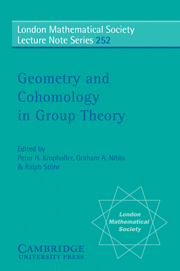Book contents
- Frontmatter
- Contents
- Preface
- List of Participants
- On the Cohomology of SL2(ℤ[1/p])
- Cohomology of Sporadic Groups, Finite Loop Spaces, and the Dickson Invariants
- Kernels of Actions on Non-positively Curved Spaces
- Cyclic Groups Acting on Free Lie Algebras
- Cohomology, Representations and Quotient Categories of Modules
- Protrees and Λ-trees
- Homological Techniques for Strongly Graded Rings: A Survey
- Buildings are CAT(0)
- On Subgroups of Coxeter Groups
- The p-primary Farrell Cohomology of Out(Fp–1)
- On Tychonoff Groups
- Word Growth of Coxeter Groups
- Poly-surface Groups
- Analytic Versions of the Zero Divisor Conjecture
- On the Geometric Invariants of Soluble Groups of Finite Prüfer Rank
- Some Constructions Relating to Hyperbolic Groups
- Free Actions of Abelian Groups on Groups
- Finitely Presented Soluble Groups
Cohomology of Sporadic Groups, Finite Loop Spaces, and the Dickson Invariants
Published online by Cambridge University Press: 01 April 2010
- Frontmatter
- Contents
- Preface
- List of Participants
- On the Cohomology of SL2(ℤ[1/p])
- Cohomology of Sporadic Groups, Finite Loop Spaces, and the Dickson Invariants
- Kernels of Actions on Non-positively Curved Spaces
- Cyclic Groups Acting on Free Lie Algebras
- Cohomology, Representations and Quotient Categories of Modules
- Protrees and Λ-trees
- Homological Techniques for Strongly Graded Rings: A Survey
- Buildings are CAT(0)
- On Subgroups of Coxeter Groups
- The p-primary Farrell Cohomology of Out(Fp–1)
- On Tychonoff Groups
- Word Growth of Coxeter Groups
- Poly-surface Groups
- Analytic Versions of the Zero Divisor Conjecture
- On the Geometric Invariants of Soluble Groups of Finite Prüfer Rank
- Some Constructions Relating to Hyperbolic Groups
- Free Actions of Abelian Groups on Groups
- Finitely Presented Soluble Groups
Summary
Introduction
Whatever one may think of a proof that covers over ten thousand pages of journal articles, some of which have still not appeared in print, the classification of finite simple groups is a remarkable theorem. It says that (apart from the cyclic groups of prime order and the alternating groups) most finite simple groups are groups of Lie type. These are the analogues of the compact Lie groups, defined over a finite field. They admit a uniform description in terms of the fixed points of certain automorphisms related to the Frobenius map, on the corresponding algebraic groups in prime characteristic. The classifying space of a finite group of Lie type fibers over that of the corresponding Lie group with fibers which are cohomologically finite away from the defining characteristic. Apart from the groups of Lie type, there are the alternating groups An (n ≥ 5), and twenty-six other groups called the sporadic simple groups.
The first five sporadic groups were discovered by Mathieu in the late nineteenth century. The remaining twenty-one were discovered in the nineteen sixties and seventies. The largest is the Fischer–Griess Monster, which has order roughly 8 × 1053. For a wealth of information on the sporadic groups and other “small” finite simple groups, the reader is referred to the ATLAS of finite groups [Atlas]. A great deal of effort has gone into trying to understand these sporadic groups.
- Type
- Chapter
- Information
- Geometry and Cohomology in Group Theory , pp. 10 - 23Publisher: Cambridge University PressPrint publication year: 1998
- 12
- Cited by

